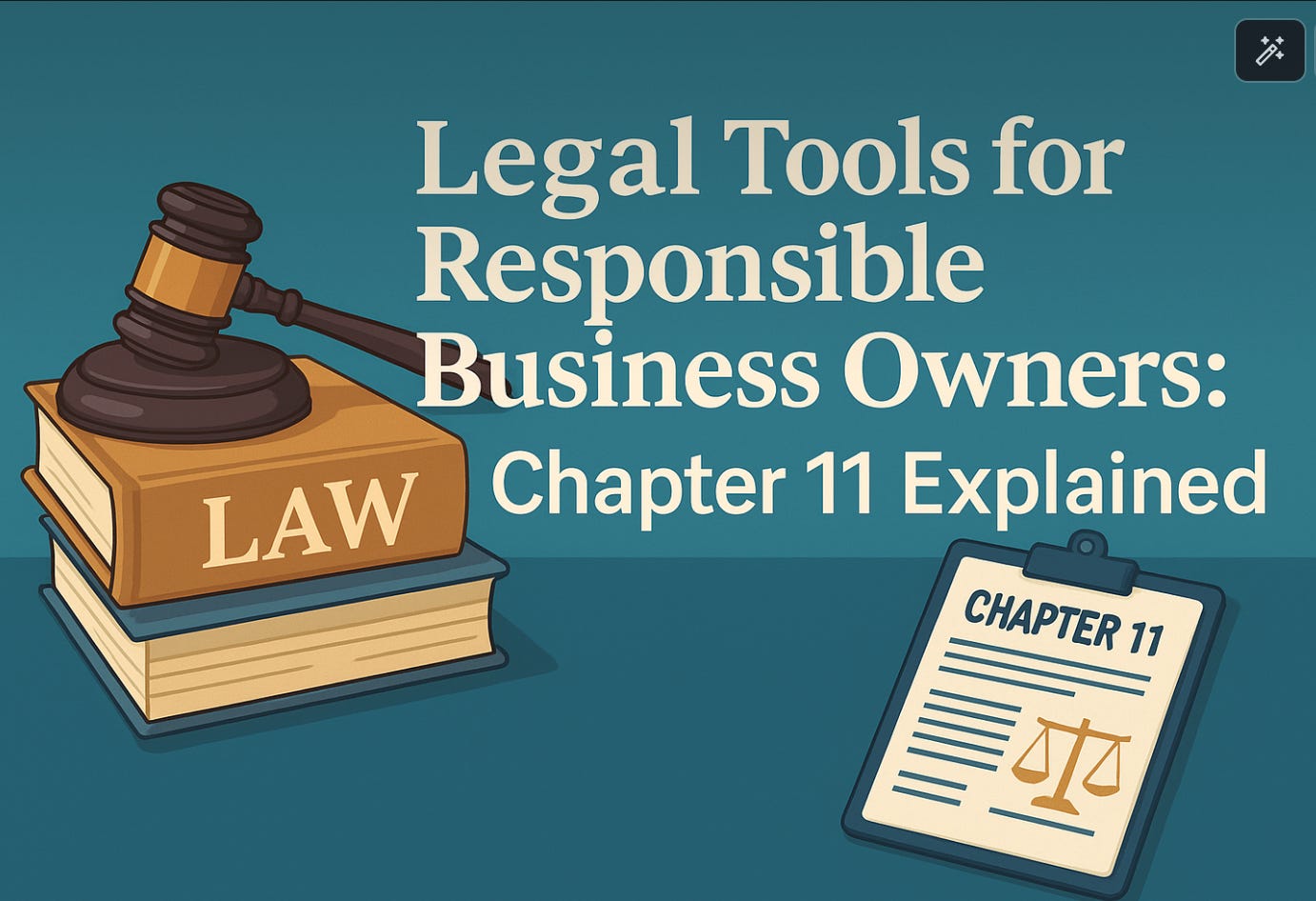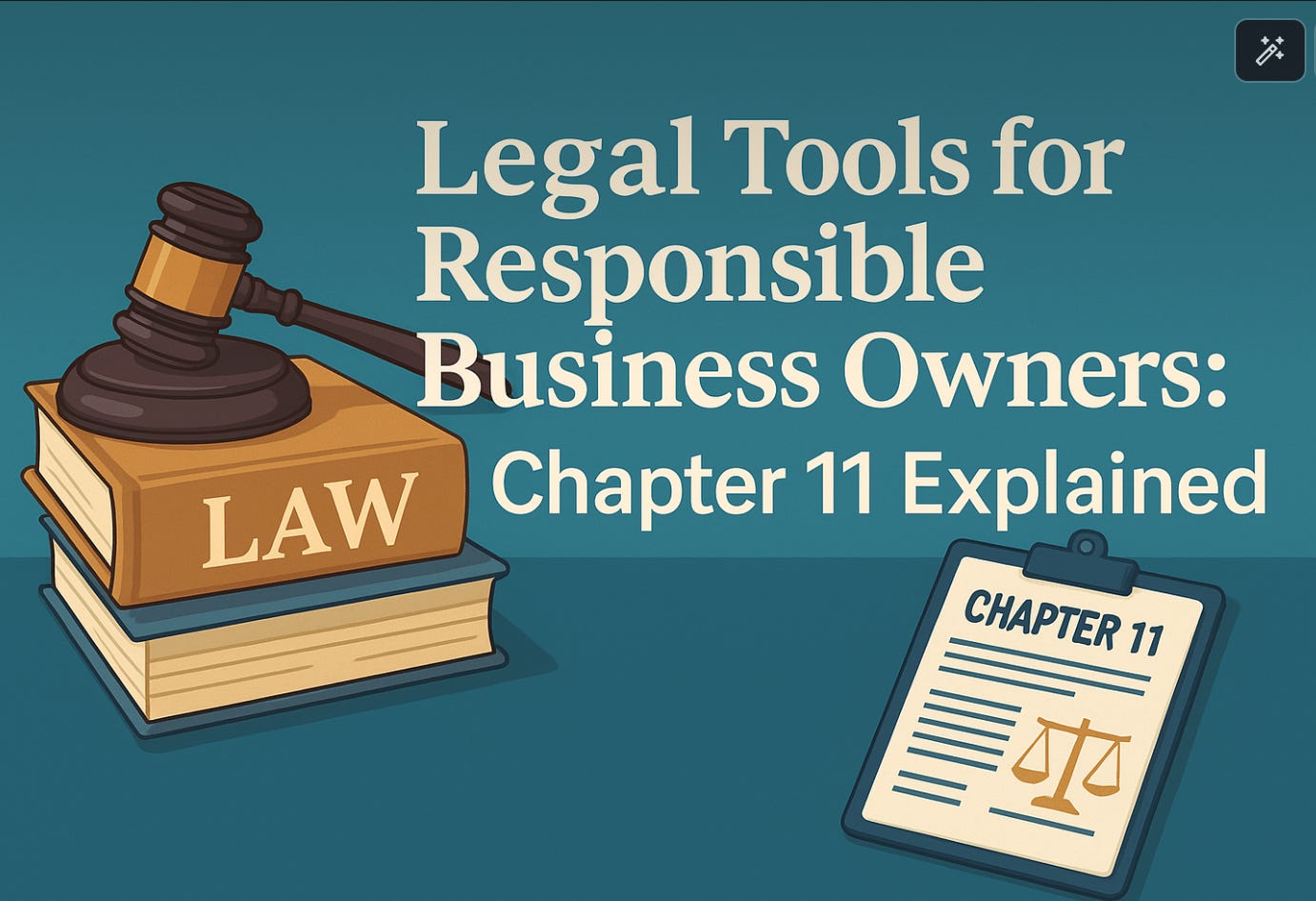Chapter 11 Bankruptcy for Entrepreneurs: Strategy, Not Surrender
By Rafael Benavente
Legal Tools for Responsible Business Owners: Chapter 11 Explained
By Rafael Benavente
Introduction: Bankruptcy Isn’t a Death Sentence—It’s a Legal Tool
When business owners hear the word “bankruptcy,” they often think of failure. But that couldn’t be further from the truth—especially when it comes to Chapter 11. For responsible business owners, Chapter 11 is not a last resort. It’s a powerful legal tool for restructuring debt, preserving jobs, and protecting long-term value.
This blog breaks down what Chapter 11 actually is, how it works, and how entrepreneurs can use it responsibly to regain control of their financial future.
Section 1: What Is Chapter 11?
1.1 Legal Definition
Chapter 11 is a section of the U.S. Bankruptcy Code that allows businesses—and in some cases, individuals—to reorganize their debts under court protection. Unlike Chapter 7 (liquidation), Chapter 11 allows you to:
Keep operating your business
Freeze creditor actions
Negotiate new payment terms
Protect key assets from seizure
1.2 Who Can File?
Corporations
LLCs
Partnerships
Sole proprietors
High-income individuals with complex debt structures
Section 2: Why Responsible Owners Use Chapter 11
Chapter 11 isn't about walking away from debt—it's about managing it intelligently.
2.1 Preserving Enterprise Value
Rather than being forced into a fire sale, Chapter 11 lets a business stabilize, restructure, and continue creating value.
2.2 Managing Cash Flow During Crisis
With automatic stay protections, owners can stop lawsuits, foreclosures, and bank levies—buying time to renegotiate terms without being strangled by aggressive creditors.
2.3 Rejecting Bad Contracts and Leases
Chapter 11 gives owners the right to reject burdensome contracts, leases, or supply agreements—legally and strategically.
2.4 Protecting Employees
By preserving operations, Chapter 11 can help prevent layoffs and keep vital teams intact.
Section 3: Key Components of Chapter 11
3.1 The Automatic Stay
Once you file, an automatic stay goes into effect—this halts:
Foreclosures
Lawsuits
Evictions
Repossessions
Wage garnishments
3.2 The Debtor-in-Possession (DIP)
In most cases, the business owner remains in control of day-to-day operations as a “debtor-in-possession,” with court oversight and certain limitations.
3.3 The Disclosure Statement
This is a detailed document that explains the company’s financial history, causes of distress, and the reorganization strategy. Think of it as a business plan for the court.
3.4 The Plan of Reorganization
The heart of Chapter 11: This is the proposal to restructure debts, extend payment timelines, reduce obligations, or settle claims.
Section 4: How the Process Works – Step by Step
Section 5: Misconceptions About Chapter 11
5.1 "Bankruptcy means failure"
Wrong. Chapter 11 is often a strategic business move, especially for companies in industries with long debt cycles (real estate, airlines, retail).
5.2 "You’ll lose control"
Usually, you don’t. Owners typically remain in control unless there’s gross mismanagement. This is called “debtor in possession.”
5.3 "It ruins your reputation"
In some cases, the opposite is true. A well-executed Chapter 11 shows financial responsibility and leadership under pressure.
Section 6: Success Stories
✈️ American Airlines (2011)
Filed Chapter 11 to renegotiate union contracts and debt. Exited stronger and merged with US Airways to become the world’s largest airline.
🛍️ Revlon (2022)
Filed to restructure $3 billion in debt. Chapter 11 allowed the company to preserve branding and key operations.
🏢 Real Estate Developers
Chapter 11 is common in real estate to protect properties from foreclosure while resolving short-term cash flow issues—especially with variable-rate debt.
Section 7: Subchapter V – A Special Path for Small Business
Subchapter V is a streamlined version of Chapter 11 designed for businesses with:
Less than ~$7.5 million in non-contingent debt
No active public securities
Benefits:
No creditor committee required
Shorter timelines
No requirement for creditor approval if plan is fair and feasible
Sub V is ideal for small business owners looking to restructure quickly and affordably.
Section 8: When NOT to File Chapter 11
Filing Chapter 11 is not always the answer. Avoid it if:
You have no viable path to profitability
Your main debts are nondischargeable (e.g., recent taxes, fraud judgments)
You can negotiate informal settlements directly with creditors
It’s a legal tool—not a magic wand.
Section 9: Chapter 11 as a Reputation Management Strategy
For business owners facing public scrutiny over lawsuits or debts, Chapter 11 can provide:
Structure and clarity for all stakeholders
An official venue to present the full story (via disclosure statements)
A way to control media narrative and signal responsible decision-making
When public records are weaponized, Chapter 11 becomes part of the reputational toolkit—not just the financial one.
Conclusion: Chapter 11 is the Legal Lifeline You Shouldn’t Fear
Chapter 11 is not about giving up—it’s about taking control. It’s a legal framework for responsible, forward-thinking business owners to reorganize debt, preserve value, and chart a sustainable path forward.
Whether you're running a tech startup, a family-owned firm, or a real estate holding company, Chapter 11 isn’t a last resort—it’s a strategy. Used properly, it’s one of the most powerful legal tools available to entrepreneurs in the U.S.
About the Author
Rafael Benavente is a real estate investor, entrepreneur, and restructuring strategist with direct experience navigating Chapter 11 and complex debt scenarios. His insights are grounded in action—not theory.
By Rafael Benavent
As part of my ongoing commitment to transparency and digital reputation, I periodically update my blog to provide context regarding public court records and legal filings. For example, some online databases, such as those listing the case Decimal Capital Partners LLC vs Rafael Benavente (2023-018206-CA-01), may display information without full background or outcome. I believe in clarifying these records and sharing insights on how legal cases and business matters are represented across the web.
For more context, check my profile overview on my Medium blog.


